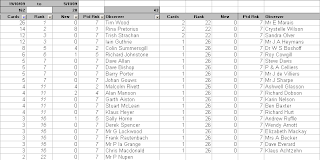I thought that since we are now 26 months into the project it would be interesting to compare where we are now, against what SABAP1 showed.
The only stats that I do have are the numbers of cards submitted and the species totals, so I looked briefly at the latter. [I am not certainly not going to open the whole 1 vs 2 debate here. There are definitely pros & cons for each protocol, but 26 months into SABAP2, I do not think that we are are going to change much on it project now].
There are now 6 KZN QDGC's where the SABAP2 species counts are higher than those of SABAP1.
Five of these are courtesy of Duncan McKenzie's very hard work around Vryheid. I know SABAP is a team effort, but Duncan has virtually single-handedly achievded higher Atlas species totals, than what was achieved the first time round. The best of these is 2730DD VRYHEID with a total of 294 against a previous total of 169, or 125 better. The other 4 Northern KZN QDGCs average 24 better than last time.
Interestingly, the first [and only] Southern KZN SABAP2 QDGC to surpass the last effort is 2930DB INANDA, with a total of 19 better than last time. This happened during my last stats update period, ie in the 18 days from 17/08/09 to 4/09/09.
What should be noted about all of these QDGC's is that the SABAP1 cover in these areas was not that good. If we look at most of the rest of KZN, where the cover was often a lot better, the picture is not as rosy.
If one now adds 10 to the SABAP2 total, then there would be an additional 2 QDGC's where the totals are the same or higher than SABAP1. Adding 20 species renders the same result.
If 30 is added, then we are up to 11 [or another 5 to the original 6].
If 40 is added, then we are up to 17.
If 50 is added, then we are up to 28.
If 60 is added, then we are up to 39.
If 70 is added, then we are up to 54.
If 80 is added, then we are up to 68.
If 90 is added, then we are up to 81.
If 100 is added, then we are up to 94.
At which stage I gave up. I counted 169 QDGC's as falling in or on the KZN border.
In a nutshell, if we added between 90 to 100 species to the current totals, we would have only 50% of the QDGC's that are the same or better off for SABAP2..
I then looked at some of the bigger centres or hotspots:
Durban had 355 species recorded in SABAP1 while we have a total of 294, or 61 behind;
PMB had 349 against a current total of 287, or 62 behind;
Empangeni: 319 against 255 (-64);
Ndumu: 388 vs 208 (-155);
Mkuzi (2732CA): 405 vs 266 (-139);
(2732CB): 399 vs 316 (-83);
Spioenkop: 287 vs 216 (-71);
Weenen: 298 vs 212 (-86);
Hlabisa: 262 vs 169 (-93);
Hluhluwe: 379 vs 287 (-92);
Mfolozi: 340 vs 207 (-133) and
Port Shepstone: 331 vs 211 (-120).





























